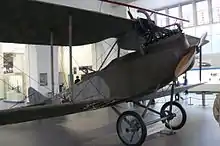Rumpler C.IV
The Rumpler C.IV was a German single-engine, two-seat reconnaissance biplane. It was a development of C.III with different tail surfaces and using a Mercedes D.IVa engine in place of the C.III's Benz Bz.IV. The Rumpler 6B 2 was a single-seat floatplane fighter variant with a 120 kW (160 hp) Mercedes D.III engine built for the Kaiserliche Marine (Imperial Navy).
| C.IV | |
|---|---|
 | |
| Role | Reconnaissance aircraft |
| Manufacturer | Rumpler Flugzeugwerke |
| Designer | Dr. Edmund Rumpler |
| Introduction | 1917 |
| Primary user | Luftstreitkräfte |
| Variants | Rumpler 6B-2 |
For a two-seater reconnaissance aircraft, Rumpler C.IV had an excellent performance, which enabled it to remain in front-line service until the end of World War I on the Western Front, as well as in Italy and Palestine. Its exceptional ceiling allowed pilots to undertake reconnaissance secure in the knowledge that few allied aircraft could reach it.
300 aircraft were licence-built by Pfalz Flugzeugwerke as the Pfalz C.I, differing in ailerons on all four wings. From February 1917 they were renamed Rumpler C.IV (Pfal).[1]
For use during filming, Slingsby Sailplanes built two Slingsby T.58 Rumpler C.IV replicas. While these were visually similar to the original aircraft, they were structurally completely different, having a steel-tube fuselage structure and wooden wings, and being powered by a de Havilland Gipsy Major engine.[2]
Variants
- Rumpler C.IV
- Pfalz C.I
- Production by Pfalz, with ailerons on all four wings: 300 built.
- Rumpler C.IV (Pfal)
- The Pfalz C.I re-designated
- Slingsby T.58 Rumpler C.IV replica
- Slingsby Sailplanes built two Slingsby T.58 Rumpler C.IV replicas. While these were visually similar to the original aircraft, they were structurally completely different, having a steel-tube fuselage structure and wooden wings, and being powered by a de Havilland Gipsy Major engine
- Rumpler 6B 2
- floatplane fighter
Specifications (C.IV)
.jpg.webp)


Data from German Aircraft Of The First World War [3]
General characteristics
- Crew: 2 (pilot and observer)
- Length: 8.41 m (27 ft 7 in)
- Wingspan: 12.66 m (41 ft 6 in)
- Height: 3.25 m (10 ft 8 in)
- Wing area: 33.5 m2 (361 sq ft)
- Empty weight: 1,080 kg (2,381 lb)
- Gross weight: 1,530 kg (3,373 lb)
- Powerplant: 1 × Mercedes D.IVa 6-cylinder water-cooled in-line piston engine, 190 kW (260 hp)
- Propellers: 2-bladed fixed-pitch propeller
Performance
- Maximum speed: 171 km/h (106 mph, 92 kn) at 500 m (1,640 ft)
- Endurance: 3½-4 hr
- Service ceiling: 6,400 m (21,000 ft) [4]
Armament
- Guns: 1 × fixed, forward-firing 7.92 mm (.312 in) LMG 08/15 with an interruptor gear and 1 × 7.92 mm (.312 in) Parabellum MG14 machine gun on a ring mounting
- Bombs: 100 kg (220 lb) of bombs
References
Notes
- Herris, Jack. Pfalz Aircraft of World War I. Great War Aircraft in Profile, Volume 4. 2001. ISBN 1891268155. P.9
- Taylor 1969, pp. 225–226.
- Gray and Thetford 1962, p.201.
- Munson 1967, p.99.
Bibliography
- Gray, Peter and Thetford, Owen. German Aircraft of the First World War. London, Putnam, 1962.
- Herris, Jack (2012). Pfalz Aircraft of WWI: A Centennial Perspective on Great War Airplanes. Great War Aviation Centennial Series. Vol. 5. Charleston, SC: Aeronaut Books. ISBN 978-1-935881-12-4.
- Herris, Jack (2014). Rumpler Aircraft of WWI: A Centennial Perspective on Great War Airplanes. Great War Aviation Centennial Series. Vol. 11. n.p.: Aeronaut Books. ISBN 978-1-935881-21-6.
- Munson, Kenneth. Aircraft of World War I. London: Ian Allan, 1967. ISBN 0-7110-0356-4.
- Munson, Kenneth. Bombers, Patrol and Reconnaissance Aircraft 1914 - 1919. ISBN 0-7537-0918-X
- Munson, Kenneth. Fighters, Attack and Training Aircraft 1914 - 1919. ISBN 0-7537-0916-3.
- Neulen, Hans-Werner & Cony, Christophe (September 2000). "Les aigles du Kaiser en Terre Sainte" [The Kaiser's Eagles in the Holy Land]. Avions: Toute l'Aéronautique et son histoire (in French) (90): 38–46. ISSN 1243-8650.
- Taylor, John W. R. Jane's All The World's Aircraft 1969–70. London: Sampson Low, Marston & Company, 1969. ISBN 0-354-00051-9.
External links
- A page about Max Psaar, an ethnic Sorbian Rumpler C.IV pilot of Luftstreitkräfte (in German).
- Page on Rumpler C.IV on website Deutsches museum